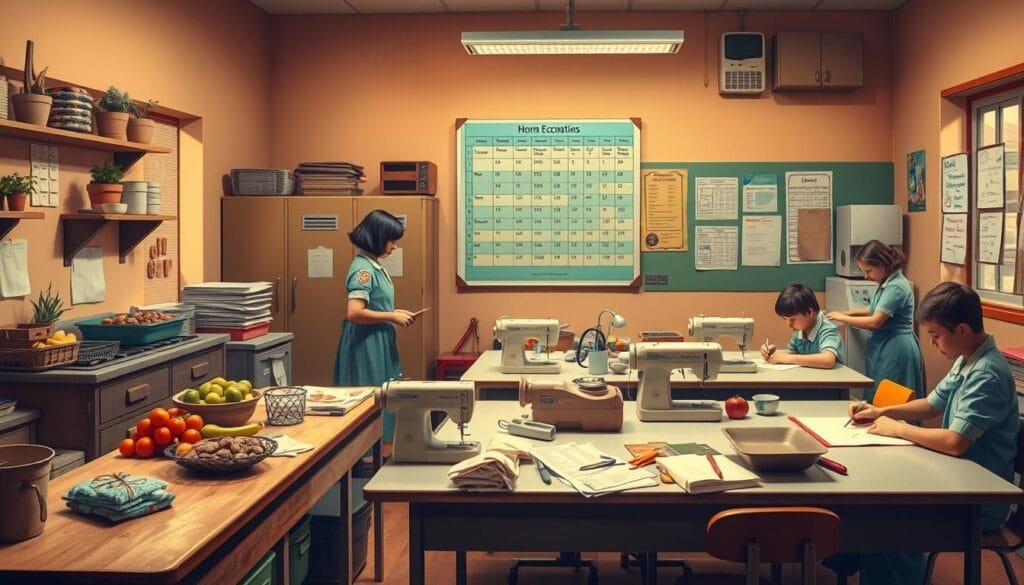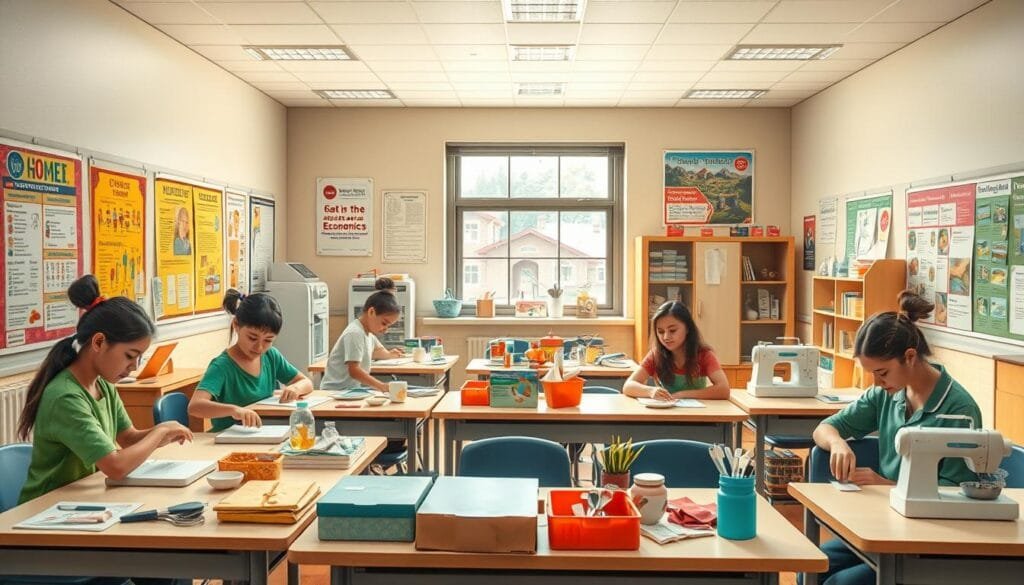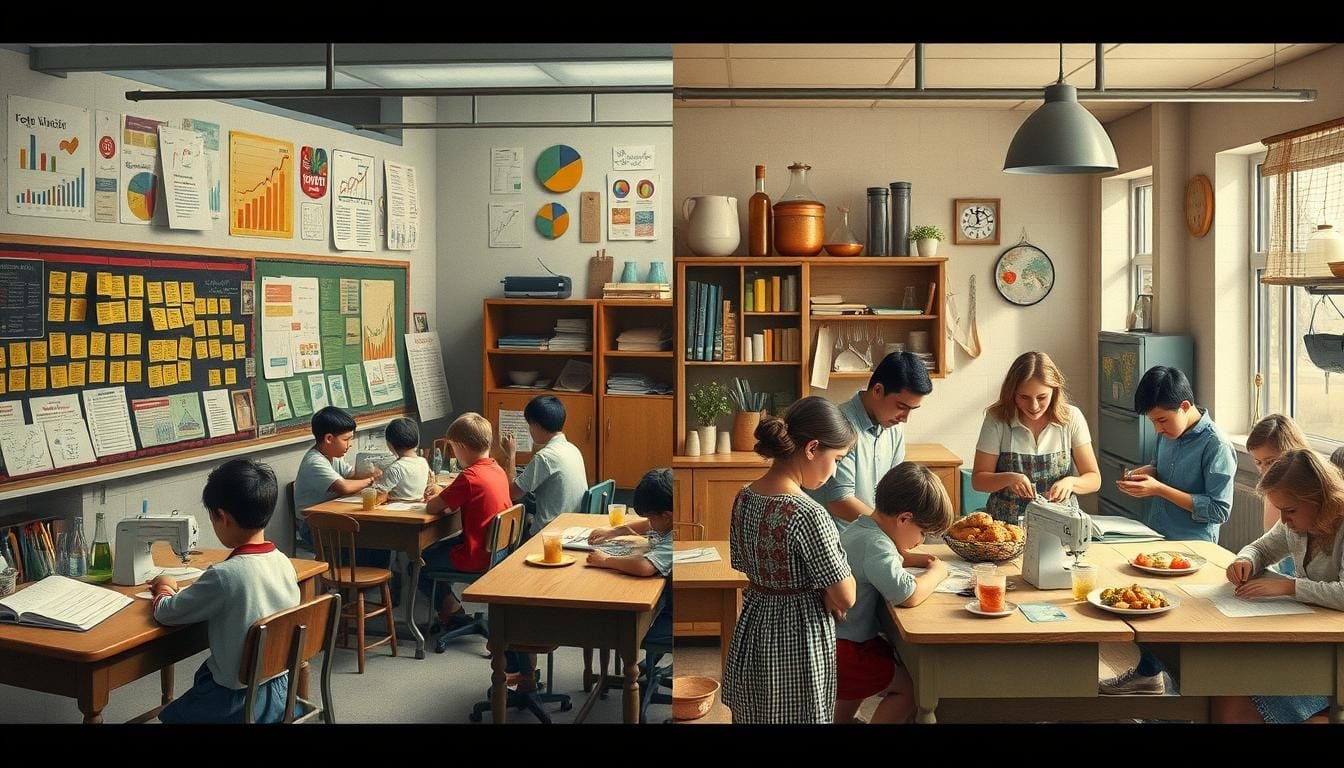Ever wondered how factual education differs from home economics? They’re often thought to be the same. But as we dive deeper, we see big differences. These differences are key in today’s educational world.
Historically, both fields have shaped education. Yet, they have unique methods and outcomes. This makes comparing them fascinating.
Home economics, now called Family and Consumer Sciences (FCS), has changed a lot. It used to focus on household skills. Now, it covers many life skills needed today. This change is crucial as more families have dual incomes and roles change.
Enrollment in FCS programs dropped 38 percent between 2002 and 2012. Still, the demand for these skills is high.
This article looks at the differences between factual subjects and home economics. We’ll see how each has evolved and their roles in education. From high school classes in Montana to key education acts, there’s a lot to discover. Learn about their unique benefits and how they prepare us for life.
Key Takeaways
- Delve into the core distinctions between factual education and home economics.
- Explore the historical roots and modern evolution of Family and Consumer Sciences (FCS).
- Understand the impact of legislative acts on the development of FCS curricula.
- Discover how changing societal dynamics influence the relevance of home economics today.
- Assess the practical applications of both educational paradigms in shaping life skills.
Introduction to Home Economics
Home economics has changed a lot since it started. It began with a focus on improving domestic skills. Now, it includes many topics that help with modern life. It covers its history, today’s uses, and how it fits into education.
Historical Context
This subject began in the mid-19th century in Scotland and grew in the United States. The Morrill Act of 1862 was key because it made certain colleges. These colleges focused on practical areas, including courses for women.
By the late 1800s, courses started using scientific ideas. The Lake Placid Conferences in 1899 pushed for this education across the U.S. Then, in 1908, the American Home Economics Association was formed. The Smith-Hughes Act of 1917 made it a key part of school programs. It moved from just domestic tasks to include things like money management.
Modern Applications
Now, home economics isn’t just about traditional skills. It includes family and consumer sciences. This area deals with managing money, taking care of families, and staying healthy. It covers everything from making smart money choices to good eating habits.
There are educational programs like Family and Consumer Sciences Related Occupations (FCSRO). They offer nine career paths, including Child Development and Education. The Californian FCCLA program also helps with career and leadership skills. This shows how home economics is linked to career training today.
Educational Integration
Adding home economics to schools has been important. Courses now range from sewing to courses that prepare you for different careers. There are three main instructional programs in Family and Consumer Sciences education. They focus on important life skills and training for specific jobs.
Special programs prepare high school students for careers. Acts like the Vocational Education Act of 1963 have supported these efforts. They ensure students get useful education for jobs. This shows why home economics is still important in education today.
What Are Facts and Home Economics The Same?
Understanding the link between educational facts and home economics can offer deep insights. While their aims are similar, their focus areas differ. This comparison helps build a strong foundation for analyzing curriculum content.
Defining Facts in Education
Educational facts focus on objective data and empirical knowledge. They cover a wide range, from math and science to socio-economic stats. Facts are the building blocks of education, aiming to equip students with essential information. This helps in making informed decisions and developing critical thinking.
Home Economics Curriculum
The home economics curriculum, now called family and consumer sciences (FACS), teaches practical life skills. The American Association of Family & Consumer Sciences (AAFCS) says it includes personal finance, nutrition, and family management. FACS uses hands-on learning to improve life quality through applied knowledge.
Today, FACS classes heavily involve technology, like online demos and dietary software. This shows a shift from traditional fact-based learning. The AAFCS supports significant educational programs, such as the National School Lunch Act, affecting education policies and practices.

Looking at how educational facts fit into home economics shows both similarities and differences. FACS might use facts about nutrition and food safety in practical lessons. Yet, the focus is on using these facts to enhance daily life, making it different from theory-only education.
| Aspect | Educational Facts | Home Economics Curriculum |
|---|---|---|
| Focus | Objective, empirical knowledge | Practical life skills and application |
| Content Areas | Various academic subjects | Personal finance, nutrition, family systems |
| Teaching Methods | Theoretical instruction and memorization | Experiential learning and technology integration |
| Outcomes | Critical thinking and informed decision-making | Improved quality of life and practical skills |
This comparison highlights how educational facts and home economics complement each other. By merging them, educators can cover both cognitive and practical student needs effectively.
Key Differences Between Facts and Home Economics
Understanding the difference between regular education and home economics shows big contrasts in their focus and teaching methods. Regular education is all about the theory. Home economics, however, teaches practical skills for everyday use.
Scope of Study
Home economics covers a variety of areas to improve personal and household abilities. These areas include:
- Food preparation and meal planning
- Grocery shopping and cooking
- House cleaning and organization
- Sewing and laundry
- Personal finance and budgeting
- Lawn care and small engine repair
- Child care
This broad range teaches students how to be independent. There’s also talk of adding more about managing a household and first aid. This would make the course even more relevant today.

Practical vs. Theoretical
Traditional schools focus much on theory. This lays the groundwork for deep thinking and academic skills. But, home economics is all about doing things and applying knowledge in the real world. Learning to change a tire or run a lawnmower is key here. These life skills help students stand on their own feet.
Home economics also grades differently, valuing hands-on skill over tests. Students keep journals to track their learning. They must do tasks by themselves to be considered skilled. This is a change from the usual focus on test results seen in other subjects.
Moreover, lessons in home economics are tailored to different ages. This ensures lessons fit well with each child’s growth stage and learning needs. This includes technology use, like organizing with Pinterest, showing modern teaching ways.
In all, the main difference between traditional subjects and home economics is in how they balance theory and practical knowledge. As the world changes, adding more practical skills to education seems key for equipping students for the future.
The Role of Home Economics in Career Development
Home economics, also known as family and consumer sciences, significantly impacts career development. It has grown beyond just domestic skills to include many job opportunities. This field is not just about cooking or sewing anymore.
Career Opportunities
A home economics degree can lead to jobs in education, textiles, family support, and even government work. People like James McIntosh have become famous worldwide, earning awards for their work in home economics. His story shows the global opportunities that come from this field. Dietitians, interior designers, and consumer scientists are examples of the diverse jobs available. These positions help tackle issues like consumerism, food shortages, and the importance of being eco-friendly.

In places like the UK and Australia, cooking and sewing are still important in home economics. Yet, there’s also a focus on new technologies like induction cooking, which is super efficient. This mix of classic and modern skills opens up new and exciting career opportunities.
Technical and Vocational Training
Vocational training in home economics has gained importance due to educational reforms like the Vocational Education Act of 1963. It’s no longer just about home skills. It now prepares students for careers in nutrition, social work, and managing hotels. These courses teach students how to make decisions, communicate well, and interact with others.
Research from Japan has found that taking initiative is key in adapting to job changes. People who can make decisions easily do better in tough situations. Home economics helps students understand how economic, social, and cultural factors influence our choices. This prepares them well for real-life challenges.
| Field | Opportunities |
|---|---|
| Education | Teachers, Curriculum Developers |
| Nutrition | Dietitians, Health Advocates |
| Textiles | Designers, Textile Technologists |
| Government and Consulting | Policy Advisors, Consumer Advocates |
| Hospitality Management | Hotel Managers, Event Planners |
Home economics plays a big role in career planning, offering many paths for vocational training. It keeps up with current needs while teaching practical skills. This ensures it remains a solid foundation for those looking to enter the professional world.
Conclusion
We’re reaching the end of our deep dive into the world of home economics. This field plays a key role in education today. It opens many career options, ranging from nutrition experts to fashion designers. Therefore, its impact is vast.
Home economics uniquely mixes hands-on and theoretical learning. This blend prepares students for various jobs and teaches essential life skills. Our fast world needs these skills more than ever. The Vocational Education Act of 1963 was a big step. It helped improve home economics programs in different schools.
The future of home economics looks bright. It will keep changing to meet our society’s new needs. Keeping up with tech and societal shifts is a must. Investing in this field helps grow capable, versatile individuals. Home economics combines many areas, like food science and money management. This ensures it stays relevant in the future.
FAQ
What are the primary differences between traditional factual education and home economics?
Traditional factual education is about learning facts and theories. It often covers abstract concepts. Home economics, on the other hand, is more hands-on. It teaches life skills like financial management and job skills. This prepares students for real life.
How did home economics evolve from its origins to modern day applications?
Home economics started in the mid-19th century in Scotland. It then grew in the USA. At first, it aimed to make home life a worthy study for both men and women. Now, it covers more topics like financial and career education. The International Federation for Home Economics tracks its growth worldwide.
What role does home economics play in contemporary educational frameworks?
Today, home economics mixes traditional and modern education needs. It offers lessons in consumer science and dietetics, and more. This prepares students for a variety of jobs. It makes them ready for the outside world.
How do educational ‘facts’ relate to the home economics curriculum?
Educational ‘facts’ are all about objective knowledge. Home economics includes these facts but also applies them practically. This blend creates a full and adaptable learning experience. It includes technical training too.
What are the key differences in the scope of study between traditional facts-based education and home economics?
Traditional education focuses on a wide range of theories. It includes abstract thinking and analyzing data. Home economics, however, is all about practical and applicable skills. It readies students for real-life problems by offering active learning.
In what ways is home economics more practical compared to theoretical education?
Home economics teaches useful skills for daily life. Think cooking, budget planning, and managing a home. This is different from traditional education. The latter often deals with abstract ideas and does not always lead to direct application.
How does home economics contribute to career development?
Home economics is key to career paths in dietetics, design, and consumer science. It lays the ground for many professions. Laws like the Vocational Education Act of 1963 back it up. They push for more vocational training.
What are the career opportunities available through home economics education?
Many career paths come from studying home economics. They include jobs in dietetics, design, consumer science, and textiles. This training prepares students well. It gives them the skills needed for various industries.
How has home economics transitioned to include technical and vocational training?
Home economics has grown to include vocational and technical lessons. This change started with reforms like the Vocational Education Act of 1963. Now, it’s not just about domestic skills. It also provides workshops for careers and life, getting students workforce-ready.
